Complete Solutions to Exercises (Linked Comprehension Type) of chapter ALKYNES of Class 11 book with complete answers and questions
| Class 11 | CHEMISTRY |
| Chapter | ALKYNES |
| CENGAGE CHEMISTRY | Exercises (Linked Comprehension Type) |
| Number Of Questions | 51 |
| Academic Year | 2023-24 |
In the following sequence of reactions, products A, B, C, D, and E are formed:
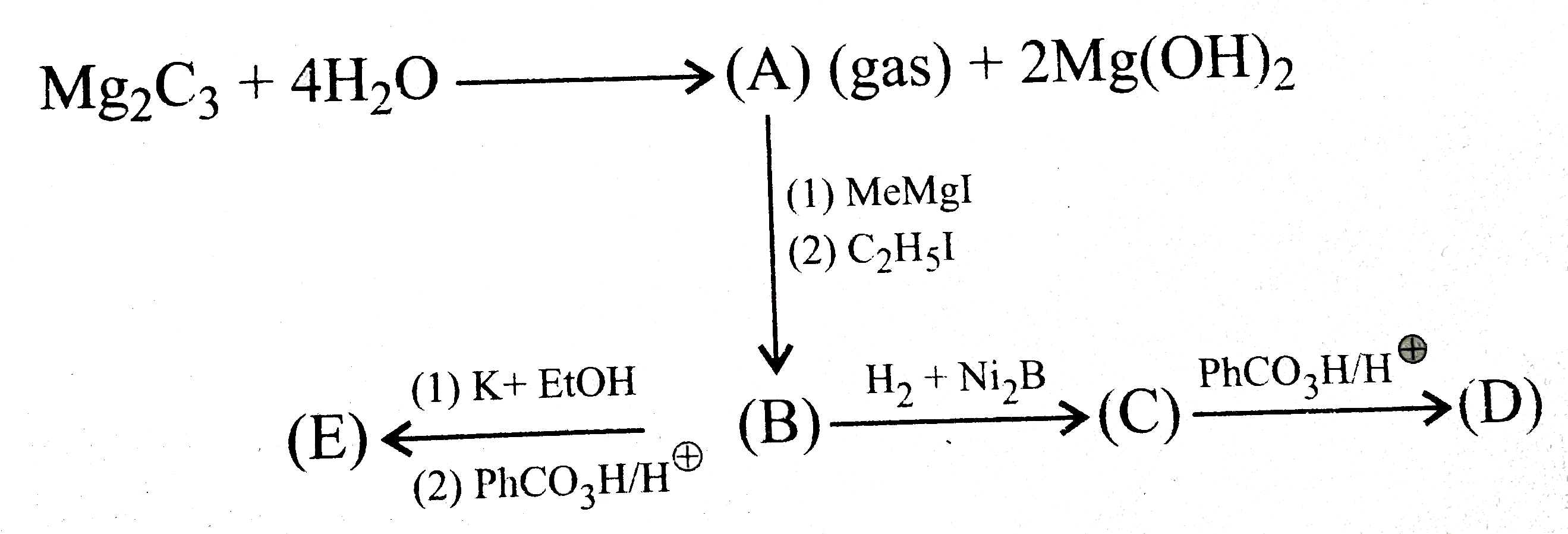
The structure of product (A) is:
View SolutionIn the following sequence of reactions, products A, B, C, D, and E are formed:

The structure of product (B) is:
View SolutionIn the following sequence of reactions, products A, B, C, D, and E are formed:

The structure of product (C) is:
View SolutionIn the following sequence of reactions, products A, B, C, D, and E are formed:

The structure of product (D) is:
View SolutionIn the following sequence of reactions, products A, B, C, D, and E are formed:

View SolutionIn the following sequence of reactions, products A, B, C, D, and E are formed:

View SolutionIn the following sequence of reactions, products A, B, C, D, and E are formed:

The structure of product (C) is:
View SolutionIn the following sequence of reactions, products A, B, C, D, and E are formed:

The structure of product (D) is:
View SolutionIn the following reaction sequence, products (A) to (G) are formed.
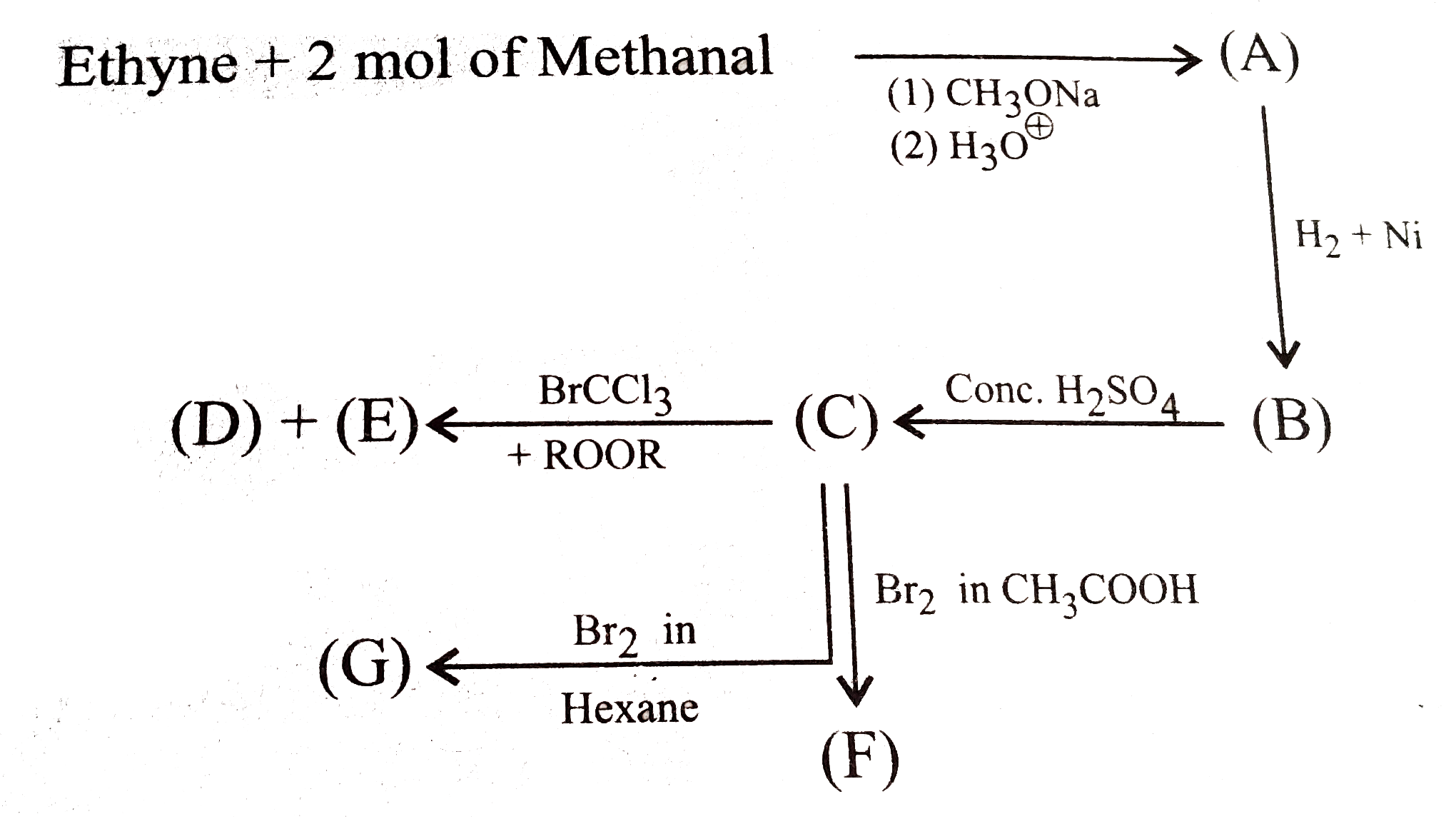
Product (A) is:
View SolutionIn the following reaction sequence, products (A) to (G) are formed.

Product (B) is:
View SolutionIn the following reaction sequence, products (A) to (G) are formed.

Product (C) is:
View SolutionIn the following reaction sequence, products (A) to (G) are formed.

Product (D) and (E) is:
View SolutionIn the following reaction sequence, products (A) to (G) are formed.

Product (F) is:
View SolutionIn the following reaction sequence, products (A) to (G) are formed.

Product (G) is:
View SolutionIn the following sequence of reactions, products (A) to (H) are formed:
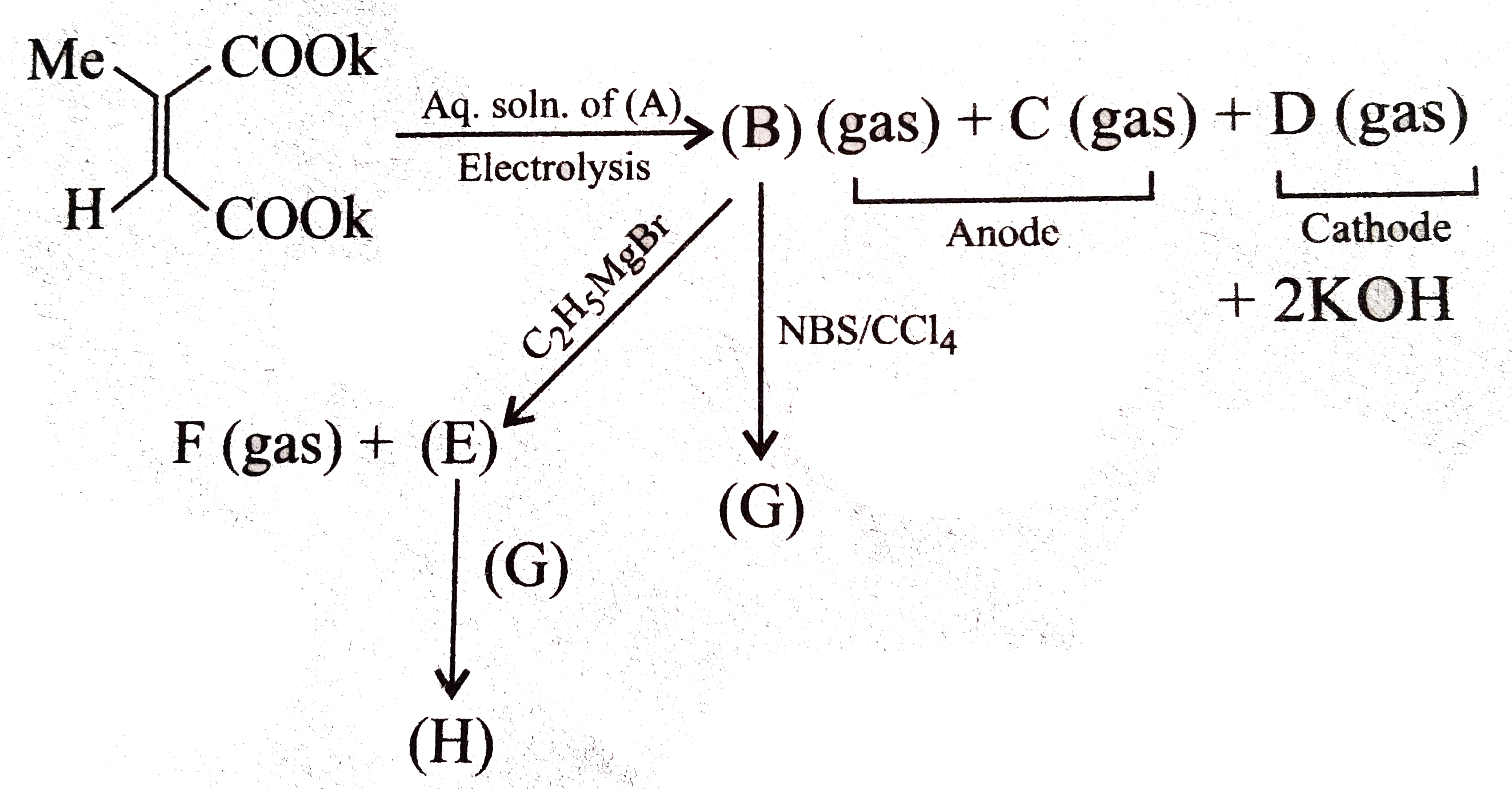
The gases (B), (C), and (D), respectively, are:
View SolutionIn the following sequence of reactions, products (A) to (H) are formed:

The gases (B), (C), and (D), respectively, are:
View SolutionIn the following sequence of reactions, products (A) to (H) are formed:

The gases (B), (C), and (D), respectively, are:
View SolutionIn the following sequence of reactions, products (A) to (H) are formed:

The gases (B), (C), and (D), respectively, are:
View SolutionInsulin contains 3.2 % sulphur. The minimum molecular weight of insulin is
View SolutionIn the following sequence of reactions, products (A) to (H) are formed:

The gases (B), (C), and (D), respectively, are:
View SolutionIn the following sequence of reactions, products (A) to (H) are formed:
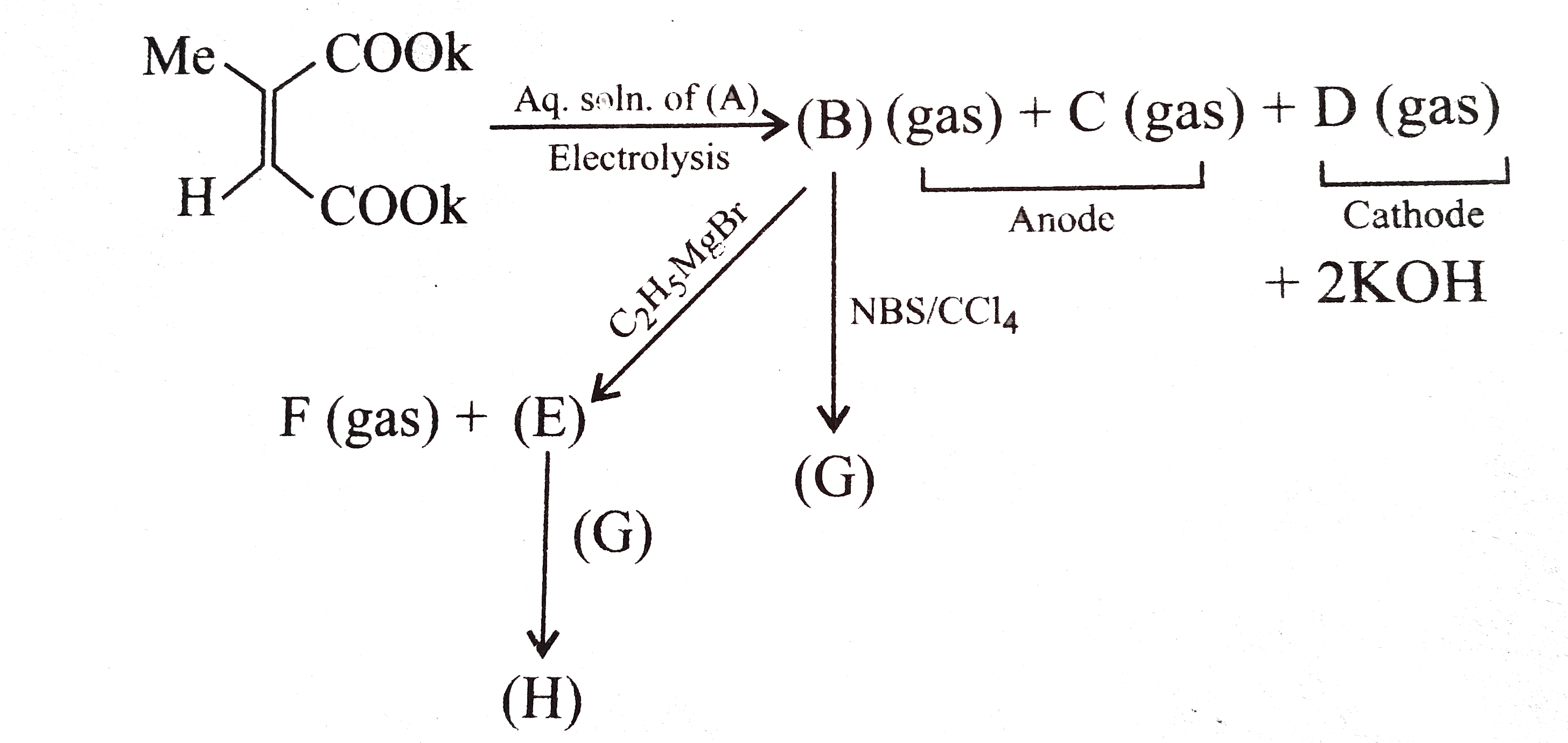
The volume of gases obtained at the anode at STP (1 bar and 298 K) when 2 faraday of electricity is passed is:
View SolutionIn the following sequence of reactions, products (A) to (H) are formed:

The volume of gases obtained at the anode at STP (1 bar and 298 K) when 2 faraday of electricity is passed is:
View Solutioni. (A), a compound with lowest number of C atoms, is unsaturated hydrocarbon and is optically active.
ii. (B), a compound with lowest number of C atoms, is unsaturated hydrocarbon and shows diastereomerism.
iii. (C), a compound with lowest number of C atoms and unsaturated hydrocarbon, shows both optical and geometrical isomerism.
Following is the reaction sequence of A, B, and C.
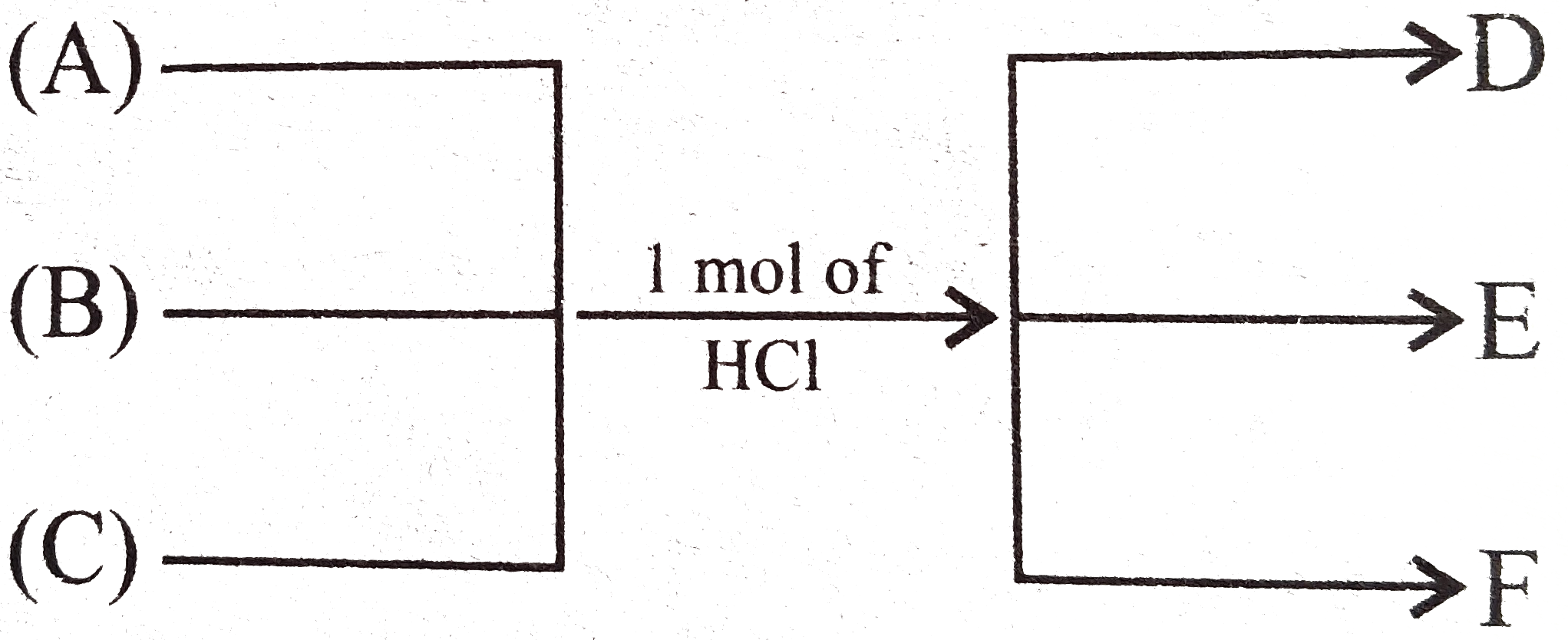
The structure of compound (A) is:
View Solutioni. (A), a compound with lowest number of C atoms, is unsaturated hydrocarbon and is optically active.
ii. (B), a compound with lowest number of C atoms, is unsaturated hydrocarbon and shows diastereomerism.
iii. (C), a compound with lowest number of C atoms and unsaturated hydrocarbon, shows both optical and geometrical isomerism.
Following is the reaction sequence of A, B, and C.

The structure of compound (B) is:
View Solutioni. (A), a compound with lowest number of C atoms, is unsaturated hydrocarbon and is optically active.
ii. (B), a compound with lowest number of C atoms, is unsaturated hydrocarbon and shows diastereomerism.
iii. (C), a compound with lowest number of C atoms and unsaturated hydrocarbon, shows both optical and geometrical isomerism.
Following is the reaction sequence of A, B, and C.

The structure of compound (C) is:
View Solutioni. (A), a compound with lowest number of C atoms, is unsaturated hydrocarbon and is optically active.
ii. (B), a compound with lowest number of C atoms, is unsaturated hydrocarbon and shows diastereomerism.
iii. (C), a compound with lowest number of C atoms and unsaturated hydrocarbon, shows both optical and geometrical isomerism.
Following is the reaction sequence of A, B, and C.

The structure of compound (D) is:
View Solutioni. (A), a compound with lowest number of C atoms, is unsaturated hydrocarbon and is optically active.
ii. (B), a compound with lowest number of C atoms, is unsaturated hydrocarbon and shows diastereomerism.
iii. (C), a compound with lowest number of C atoms and unsaturated hydrocarbon, shows both optical and geometrical isomerism.
Following is the reaction sequence of A, B, and C.

The structure of compound (E) is:
View Solutioni. (A), a compound with lowest number of C atoms, is unsaturated hydrocarbon and is optically active.
ii. (B), a compound with lowest number of C atoms, is unsaturated hydrocarbon and shows diastereomerism.
iii. (C), a compound with lowest number of C atoms and unsaturated hydrocarbon, shows both optical and geometrical isomerism.
Following is the reaction sequence of A, B, and C.

The structure of compound (F) is:
View SolutionIn the following sequence of reactions, products (B) to (E) are formed:

Product (B) is:
View SolutionIn the following sequence of reactions, products (B) to (E) are formed:

Product (C) is:
View SolutionIn the following sequence of reactions, products (B) to (E) are formed:

Product (D) is:
View SolutionIn the following sequence of reactions, products (B) to (E) are formed:

Product (E) is:
View SolutionIn the following sequence of reactions, products (B) to (E) are formed:

Product (B) is:
View SolutionSelect the correct statements:
View SolutionIn the following sequence of reactions, the products (A) to (G) are formed:
i. `2CH_4(g)overset(Delta)underset(1773K)rarr(A)(g)+B(g)`
ii. `4 mol of (A) overset(Delta)underset(Ni(CN)_4+THF)rarr(C)overset(O_3//o x id.)rarr(D) only`
iii. `(A)overset((1) 1 mol of NaNH_2)underset((2) C_2H_5I)rarr(E)underset(Red hot tube)overset(3 mol of E)rarrunderset((G) only)underset(darr O_3//Red.)F`
Compounds (A) and (B), respectively, are:
View SolutionIn the following sequence of reactions, the products (A) to (G) are formed:
i. `2CH_4(g)overset(Delta)underset(1773K)rarr(A)(g)+B(g)`
ii. `4 mol of (A) overset(Delta)underset(Ni(CN)_4+THF)rarr(C)overset(O_3//o x id.)rarr(D) only`
iii. `(A)overset((1) 1 mol of NaNH_2)underset((2) C_2H_5I)rarr(E)underset(Red hot tube)overset(3 mol of E)rarrunderset((G) only)underset(darr O_3//Red.)F`
Compounds (A) and (B), respectively, are:
View SolutionIn the following sequence of reactions, the products (A) to (G) are formed:
i. `2CH_4(g)overset(Delta)underset(1773K)rarr(A)(g)+B(g)`
ii. `4 mol of (A) overset(Delta)underset(Ni(CN)_4+THF)rarr(C)overset(O_3//o x id.)rarr(D) only`
iii. `(A)overset((1) 1 mol of NaNH_2)underset((2) C_2H_5I)rarr(E)underset(Red hot tube)overset(3 mol of E)rarrunderset((G) only)underset(darr O_3//Red.)F`
Compound D is:
View SolutionIn the following sequence of reactions, the products (A) to (G) are formed:
i. `2CH_4(g)overset(Delta)underset(1773K)rarr(A)(g)+B(g)`
ii. `4 mol of (A) overset(Delta)underset(Ni(CN)_4+THF)rarr(C)overset(O_3//o x id.)rarr(D) only`
iii. `(A)overset((1) 1 mol of NaNH_2)underset((2) C_2H_5I)rarr(E)underset(Red hot tube)overset(3 mol of E)rarrunderset((G) only)underset(darr O_3//Red.)F`
Compound (E) is
View SolutionIn the following sequence of reactions, the products (A) to (G) are formed:
i. `2CH_4(g)overset(Delta)underset(1773K)rarr(A)(g)+B(g)`
ii. `4 mol of (A) overset(Delta)underset(Ni(CN)_4+THF)rarr(C)overset(O_3//o x id.)rarr(D) only`
iii. `(A)overset((1) 1 mol of NaNH_2)underset((2) C_2H_5I)rarr(E)underset(Red hot tube)overset(3 mol of E)rarrunderset((G) only)underset(darr O_3//Red.)F`
Compound F is
View SolutionIn the following sequence of reactions, the products (A) to (G) are formed:
i. `2CH_4(g)overset(Delta)underset(1773K)rarr(A)(g)+B(g)`
ii. `4 mol of (A) overset(Delta)underset(Ni(CN)_4+THF)rarr(C)overset(O_3//o x id.)rarr(D) only`
iii. `(A)overset((1) 1 mol of NaNH_2)underset((2) C_2H_5I)rarr(E)underset(Red hot tube)overset(3 mol of E)rarrunderset((G) only)underset(darr O_3//Red.)F`
Compounds G is
View SolutionDraw Organic Structure of ethane
View SolutionDraw the Structure of Propane Which is 3rd member of alkane family
View SolutionDraw the Structure of butane Which is 4th member of alkane family
View SolutionCompound `CH_3CH_2OH` is:
View SolutionDraw the Structure for Ethanol
View SolutionThe suffix in ethanol is used to Define Which functional Group
View SolutionIn the following sequence of reactions, products A to D are formed:

The structure of product (B) is:
View SolutionIn the following sequence of reactions, products A to D are formed:

The structure of product (C) is:
View SolutionIn the following sequence of reactions, products A to D are formed:

The structure of product (D) is:
View SolutionIn the following sequence of reactions, products B to E are formed:

The structure of product (E) is:
View SolutionIn the following sequence of reactions, products B to E are formed:

The structure of ozonalysed product P is
View Solution
Exercises (Linked Comprehension Type) questions and complete solutions for chapter ALKYNES of CENGAGE CHEMISTRY (ENGLISH) of Class 11
All Exercises from CENGAGE CHEMISTRY Class 11 CHEMISTRY ALKYNES
- Exercises (Archives - Analytical and Desriptive Type)
- Exercises (Archives - Fill in the Blanks Type)
- Exercises (Archives - Single Correct Answer Type)
- Exercises (Linked Comprehension Type)
- Exercises (Multiple Correct Answers Type)
- Exercises (Single Correct Answers Type)
- Exercises (Subjective Type)
- Illustrations
- Solved Examples